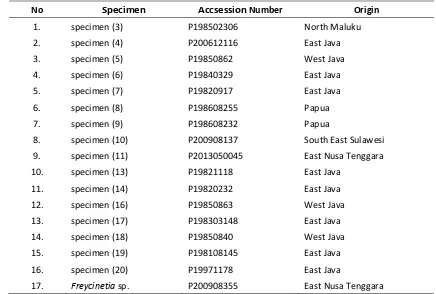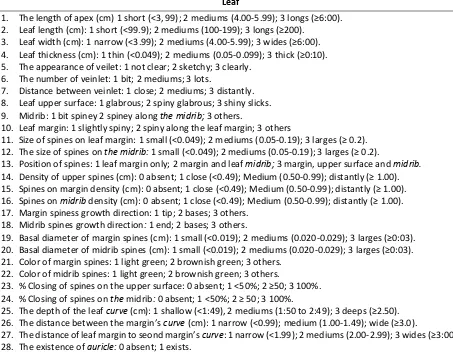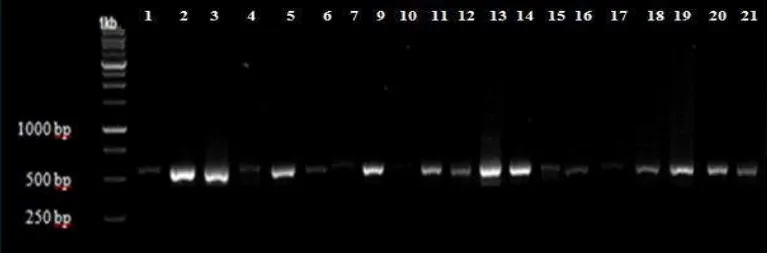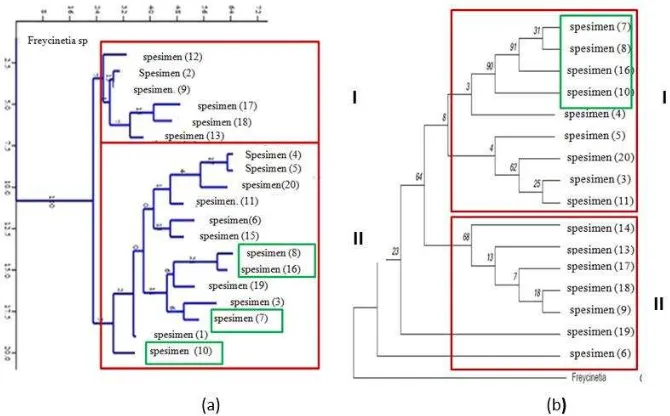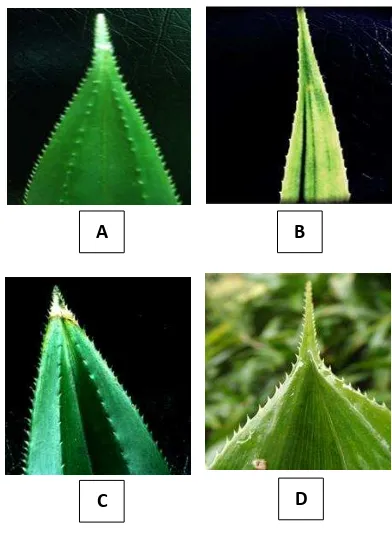The Analysis of
Pandanus
Relationship of Purwodadi Botanical Garden
Collections Based on Morphological Character and Molecular Marker
(
trnL
and
trnL-F
)
Risca Adiyani Rachma1*, Hendrian2, Rodiyati Azrianingsih1
1Department of Biology, Fakulty of Mathemathics and Natural Sciences, University of Brawijaya 2Purwodadi Botanical Garden-Institute of Indonesia Science, Pasuruan
Email: [email protected]*, [email protected], [email protected]
ABSTRACT
The morphological characteristics of plant vegetative organ has the potential to be the defining factor of pandanus family collection at Purwodadi Botanical Garden (PBG). However, the information is not enough to confirm the identity of pandanus at the type-level. This problem happened at the collection of PBG. It is an urgent issue considering PBG as one of the most important ex-situ plant conservation institute that also has function as a study source for plant taxonomy science in Indonesia. Therefore, the use of molecular technology analysis using molecular marker (primer) is incredibly important to identify the member of pandanus family by identifying its family relationship pattern. This information was expected to give a clarity about the identity of Pandanus family at PBG which will support further research and activity for pandanus conservation. The plant sample includes 16 specimens of pandanus with one member of the family from Freycinetia as the outgroup. Morphological analysis of the 50 characteristics of vegetative organs (leaf, stem, and root) was conducted. Molecular analysis of DNA using primer of trnL and trnL-F. The data sequence as a result of the analysis was then tested using homology test with BLAST. All of the DNA sequence was paralleled using Clustal W analysis, the tree construction relationship was analysed using Maximum Parsimony (MP) method with
MEGA 6.0 program. The results of morphological studies showed the character vegetative that is the position of the spines on the leaves, the shape of apex leaf and the condition of the root surface above the soil. Molecularly, appears 1 new genera that has not been previously identified by PBG researcher is Benstonea.
Keyword: Morphology; Pandanus; Phylogenetic;Primer trnL;trnL-F.
INTODUCTION
Risca Adiyani Rachma et al. : The Analysis of Pandanus Relationship of ... 130
of generative organs can also be caused by external factors such as habitat changes of environment as well as internal factors of N and P content in generative pandan organs (Minden & Kleyer, 2014). Incomplete generative organs can be represented by vegetative organs in overcoming difficulties in determining the position of the pandan taxon.
Determining taxon positions may be based on morphological character of vegetative organ as it has more easily visible and available character over time (Rahayu & Handayani, 2008), so it can be quickly and rapidly assessed. Although the vegetative organ is susceptible to change due to its high plasticity, it is important for certain plant species of taxonomy such as Pandanus (Hidayat et al., 2008). Research of Rachma et al., (2013) previously mentioned that character of vegetative organ is quite adequate as distinguishing feature among genera. Some of the vegetative organ characters becoming the key of distinguishing types are the presence and position of spines on pandan leaves, the apex shape, and the condition of the root surface above the soil. However, these characters are less able to confirm the identity of some pandan collection at the species level. This is a p o le that o u s i PBG’s pandan collection.
Difficulty in determining the position of pandanus taxon which is undergone by PBG needs to be solved immediately, considering PBG as one of the ex-situ plant conservation institutions, it becomes one of the learning sources of taxonomic plants in Indonesia (Soerohaldoko et al., 2001). Therefore, the use of molecular analysis technology becomes a very effective alternative way to obtain more comprehensive information about the supporting character of Pandanus identity through the pattern of kinship
relationship (Shukla & Misra, 1997). So far, research on phylogeny based on Pandanus DNA analysis has not been done much except by Callmander (Callmander & Laivao, 2003). In Indonesia, research on pandanus is still limited to genetic diversity (Panda et al., 2012; Wakte et al., 2012). This genetic information is expected to be used to confirm the taxon position of the pandan based on the vegetative organ that has been done before.
One of molecular markers commonly used by researchers to determine the phylogenetics of plant is by chloroplast DNA (trnL and trnL-F). Both primers are very effective in identifying members of the Pandanaceae (Callmander et al., 2012; Callmander et al., 2013; Gallaher et al., 2015). It is also supported by the advantages of two primers such as simple genomes because they have a medium-size genome length between 260-1000 bp, stable genetic structure, never or very rarely undergoing gen recombination, making it easy to amplify and to analyze (Dong et al., 2012; Hidayat et al., 2008). According to Buerki et al., (2012); Callmander et al., (2012); Gallaher et al., (2015); Santos et al., (2011), several members of the Pandanus have been analyzed for their phylogenetic using trnL-F. The phylogenetic research in Pandanus mangalorensis using trnL has also been done by Zanan & Nadaf, (2012).
MATERIALS AND METHODS
Plant samples.
Samples are collections of Purwodadi Botanical Garden, Pasuruan, East Java that result of exploration from various regions in Indonesia (Table 1). The plant sample includes 20 pandan specimens and one specimen is Freycinetia as outgroup.
Table 1. Pandan Collection Specimen Purwodadi Botanical Garden
No Specimen Accsession Number Origin
1. specimen (3) P198502306 North Maluku
2. specimen (4) P200612116 East Java
3. specimen (5) P19850862 West Java
4. specimen (6) P19840329 East Java
5. specimen (7) P19820917 East Java
6. specimen (8) P198608255 Papua
7. specimen (9) P198608232 Papua
8. specimen (10) P200908137 South East Sulawesi
9. specimen (11) P2013050045 East Nusa Tenggara
10. specimen (13) P19821118 East Java
11. specimen (14) P19820232 East Java
12. specimen (16) P19850863 West Java
13. specimen (17) P198303148 East Java
14. specimen (18) P19850840 West Java
15. specimen (19) P198108145 East Java
16. specimen (20) P19971178 East Java
17. Freycinetia sp. P200908355 East Nusa Tenggara
DNA Isolation.
Isolation of DNA from young leaves using Genomic DNA Purification Kit (Promega), which consists of nucleus lysis solution, precipitation protein, RNase and DNA rehydration solution (10mM Tris-HCl (pH 7.4), EDM 1 mM (pH 8.0)). The method used based on the technique on the plant plus the modification of overnight incubation process at 4°C after addition of isopropanol. The qualitative DNA test used agarose electrophoresis gel method (1%) with Ethidiu B o ide EtB of μL dissol ed i 1x TBE solution. The isolated DNA samples were then visualized using a UV transilluminator with DNA ladder SizerTM
DNA Marker 1000 PLUS. Quantitative DNA used absorbance test, 260 and 280 nm (Fatchiyah et al., 2011; Hapsari et al., 2015).
Amplifikasi PCR.
The primer used are trnL-F forward (5'-CGAAATCGGTAGACGTACG-3 ') and reverse (5'-ATTTGAACTGGTGACACGA-3'), and trnL
Risca Adiyani Rachma et al. : The Analysis of Pandanus Relationship of ... 132
seconds) and extention final (1x): 72°C for 10 minutes. The qualitative DNA test was performed using gel electrophoresis method (1.2%), Ethidium Bromide (EtBr of μL, the
visualized. The amplified DNA samples of 30 μL e e used fo se ue i g (Fatchiyah et al., 2011; Hapsari et al., 2015).
Data Analysis
The sequenced result data was done by homology test through BLAST on NCBI with ho olog le el ≥ %. All se ue es of sequenced (in group and out group) sequence alignment using the Clustal W program in the MEGA 6.0, with statistical program to generate the phylogeny tree (cladogram) by Maximum Parsimony (MP) method. This uses the aligned sequence by comparing sequence characters directly. The
last step is consensus the cladogram of each primer (trn L and trnL-F).
The primery data which is the result of the vegetative character description (leaves, stems and roots) and generates 50 characters which will be followed by the observation and measurement process on each character (Table 2). Furthermore, the measurement data results are given multistate scoring (0, 1, 2 and 3). This is intended to facilitate the grouping and analysis of data. Further assessment data were analyzed using the Maximum Parsimony (MP) method using the PAST 1.34 program to build the phylogeny tree (dendrogram). The next final stage is consensus phylogeny tree by vegetative characters (dendrogram) and molecular (cladogram).
Table 2. Morphological Characters and MultistateScoring of Vegetative Organ.
Leaf
1. The length of apex (cm) 1 short (<3, 99); 2 mediums (4.00-5.99); 3 longs ≥ : . 2. Leaf length (cm): 1 short (<99.9); 2 mediums (100-199); 3 longs ≥ .
3. Leaf width (cm): 1 narrow (<3.99); 2 mediums (4.00-5.99); 3 wides ≥ : . 4. Leaf thickness (cm): 1 thin (<0.049); 2 mediums (0.05-0.099); 3 thick ≥ : . 5. The appearance of veilet: 1 not clear; 2 sketchy; 3 clearly.
6. The number of veinlet: 1 bit; 2 mediums; 3 lots.
7. Distance between veinlet: 1 close; 2 mediums; 3 distantly. 8. Leaf upper surface: 1 glabrous; 2 spiny glabrous; 3 shiny slicks. 9. Midrib: 1 bit spiney 2 spiney along the midrib; 3 others.
10. Leaf margin: 1 slightly spiny; 2 spiny along the leaf margin; 3 others
11. Size of spines on leaf margin: 1 small (<0.049); 2 mediums (0.05-0.19); la ges ≥ 0.2). 12. The size of spines on the midrib: 1 small (<0.049); 2 mediums (0.05-0.19); la ges ≥ 0.2).
13. Position of spines: 1 leaf margin only; 2 margin and leaf midrib; 3 margin, upper surface and midrib.
14. Density of upper spines (cm): 0 absent; 1 close (<0.49); Medium (0.50-0.99); distantly ≥ 1.00). 15. Spines on margin density (cm): 0 absent; 1 close (<0.49); Medium (0.50-0.99); distantly ≥ 1.00). 16. Spines on midrib density (cm): 0 absent; 1 close (<0.49); Medium (0.50-0.99); distantly ≥ 1.00). 17. Margin spiness growth direction: 1 tip; 2 bases; 3 others.
18. Midrib spines growth direction: 1 end; 2 bases; 3 others.
19. Basal diameter of margin spines (cm): 1 small (<0.019); 2 mediums (0.020-0.029); 3 larges ≥ : . 20. Basal diameter of midrib spines (cm): 1 small (<0.019); 2 mediums (0.020-0.029); la ges ≥ : . 21. Color of margin spines: 1 light green; 2 brownish green; 3 others.
22. Color of midrib spines: 1 light green; 2 brownish green; 3 others.
23. % Closing of spines on the upper surface: 0 absent; 1 <50%; 2 ≥ ; 3 100%. 24. % Closing of spines on the midrib: 0 absent; 1 <50%; 2 ≥ 50; 3 100%.
25. The depth of the leaf curve (cm): 1 shallow (<1:49), 2 mediums (1:50 to 2:49); 3 deeps ≥ . . 26. The distance bet ee the a gi ’s curve (cm): 1 narrow (<0.99); medium (1.00-1.49); wide ≥ . .
Leaf
29. Auricle size: 0 absent; 1 short (<2.9); 2 mediums (3.0-4.9); 3 longs ≥ . . 30. Auricle Width (cm): 0 absent; 1 short (<2.9); 2 mediums (3.0-4.9); 3 wides ≥ . . 31. The existence of spines on the margin of auricle: 0 Absent: 1 exist.
32. Frequency of spines on auricle: 0 absent; 1 close (<0.049); 2 mediums (0.05-0.099); 3 rare ≥ . . 33. Length of auricle spines: 0 absent; 1 short (<0.049); 2 mediums (0.05-0.099); 3 longs ≥ 0.1) 34. The Color of auricle: 0 absent, 1 white; 2 greens; 3 others.
35. Length of sheath (cm): 1 short (<1.9); 2 mediums (2.0-3.9); 3 longs ≥ . . 36. Width of sheath (cm): 1 narrow (<3.9); 2 mediums (4.0-5.9); 3 wides ≥ . . 37. Sheath position to stem: 1 does not cover; 2 covering the sheath; 3 overlapping.
38. Apex shape 1 acute; 2 acuminate; 3 others. 39. Leaf shape: 1 linnear; 2 oblongata; 3 others
40. Leaf upper surface color: 1 light green; 2 dark green; 3 others. 41. Leaf bottom surface color: 1 light green; 2 dark green; 3 others 42. Leaf scent: 0 absent; 1 less fragrance; 3 fragrances.
Stem
43. Stem length (cm): 1 short (<0.99); 2 mediums (1.00-1.99); 3 longs ≥ . . 44. Stem diameter (cm): 1 small (<1.99); 2 mediums (1.00-1.99); 3 larges ≥ . . 45. Stem surface condition: 1 former leaf sitting; 2 thorns; 3 others.
46. Stem color: 1 light brown; 2 browns; 3 others. 47. Stem growth Direction: 1 upright; 2 spreads; 3 others.
Root
48. Character of roots above the ground: 1 prop roots; 2 lianas; 3 others. 49. Root surface above ground: 1 thorny/nodule; 2 smooths; 3 others. 50. Tree height (cm): 1 short (<99); 2 mediums (100-199); 3 high ≥ 200).
RESULT AND DISCUSSION DNA Amplification
Based on the results of isolation and DNA amplification of two primers, shows that only some specimens are successfully well amplified. Primer trnL, there were 20 OTUs that were successfully amplified except spesimen (2) (Figure 1).
Risca Adiyani Rachma et al. : The Analysis of Pandanus Relationship of ... 134
Primer trnL-F, there are 18 OTUs that can be amplified except spesimen (1), spesimen (7), and spesimen (12) (Figure 2). OTU that have thick band can be analyze to sequencing stage. In this study used each of 17 of 21 OTU to be analyzed kinship relationship.
Variasi Sekuen DNA
Polymorphisms analysis of 450 nucleotide based on primer trnL of 17 OTU that has been alignmented. The alignment results indicate that as many as 180 (40%) characters are conserved areas (Table 3). The conserved area is an area that has a nucleotide bases position that does not changes, so it is a primitive character (plesiomorph) (Hidayat & Pancoro, 2008).
Figure 2. PCR product of primer trnL-F:1. spesimen(19); 2. Freycinetia sp.; 3. spesimen(18); 4. spesimen(13); 5. spesimen (17); 6 spesimen(2); 7. spesimen (4); 8. spesimen (14); 9. spesimen (3); 10. spesimen (5); 11. spesimen(16); 12. spesimen (6); 13. spesimen (8); 14. spesimen(9); 15. spesimen (10); 16. spesimen (7); 17. spesimen(20); 18. spesimen(11).
Polymorphic variables as 198 (44%) characters and 72 (16%) are gaps or missing nucleotide bases. Singletone which is auupperomorph variation of nucleotide bases sequences of 190 characters and parsimony informative are 8 characters. Singletone variation is a nucleotide bases that change that at least once in a single OTU (Hidayat & Pancoro, 2008). The Results of polymorphism analysis using trnL-F obtained 658 nucleotide bases of 17 OTU. The position of conserved bases is 586 (89.05%) with character of polymorphic base position is 22 (3.34%) characters and 50 (7.59%) characters are missing base position (gaps) in the sequence. As for the variation singletone, 14 characters and 8 characters are parsimony informative.
Table 3. The Results of Polymorphism Analysis of DNA Sequences By 2 Primers
Primers Total Character by Alignment
Total Character Conservation
Total Character
Singletone
Total Character Informative Parsimony
trnL 450 180 190 8
trnL-F 658 586 14 8
of the same specimen that forming clade I. Differences in the composition of the specimen of pandan does not significantly affect the specimen grouping based on morphological and molecular. In fact, the two phylogenetic trees support each other.
Figure 3. Phyilogenetic tree: (a) morphology dan (b) moleculer (trnL dan trnL-F).
Note: (red) Pandanus grouping; Green: existance of Benstonea.
Phylogenetic by Molecular.
Based on the cladogram using MP analysis method (Figure 3b), seen the establishment of two major clades. Clade I consists of 9 OTU, clade II consists of 5 OTU. Both clades are supported by different bootstrap values on each branch. In addition, there are 3 monophyletic branches, the first monophyletic with bootstraps value is 31, which is between the spesimen (7) and spesimen (8). The autopmorphs formed between the two are 1 transversion, 4 transitions, and 2 insertions total is 17 mutations. According to Hapsari et al. (2015) the number of autopomorphs indicates the adaptation of the individu to the environment. This monophyletic has highest bootstrap value and supported by the genetic distance of 0.007 (Appendix 1). Second monophyletic has a bootstrap value of 25, are between the spesimen (3) and spesimen (11). Both OTU were formed by autopomorphs of 2 transversions, 4 transitions, and 5 insertions with a total
mutation of 52 with a genetic distance of 0.002. The third monophyletic is between the spesimen (16) and (9) with autopomorphs of 2 transversions, 4 transitions, and 3 insertions with a total of 55 mutations. The genetic distance formed by the third monophyletic is 0.012. Wijayanto et al. (2013) said that the greater value of genetic distance indicates a far relationship.
Phylogenetic by Morphology Characters Based on the results of phylogenetic trees using vegetative organs characters of 21 OTU seen formation of two major clades (Figure 3a). Both clades are formed based on morphological characters of vegetative organs. There are 3 characters that can be differentiating in pandan grouping in morphology.
Spines Position on Leaf.
1
3
6
Appendix 1. Consensus Genetic Distance of 17 OUT Pandan Purwodadi Botanical Garden Collection.
No. 1 2 3 4 5 6 7 8 9 10 11 12 13 14 15 16 17
1 Freycinetia_sp. 0.003 0.003 0.003 0.003 0.004 0.005 0.003 0.004 0.003 0.003 0.003 0.086 0.009 0.003 0.004 0.003
2 spesimen._(3) 0.009 0.001 0.002 0.002 0.003 0.004 0.003 0.003 0.001 0.002 0.002 0.081 0.008 0.002 0.003 0.002
3 spesimen._(4) 0.008 0.002 0.001 0.002 0.003 0.003 0.002 0.002 0.001 0.002 0.001 0.081 0.008 0.001 0.002 0.001
4 spesimen._(5) 0.009 0.003 0.001 0.002 0.003 0.004 0.003 0.002 0.002 0.002 0.002 0.081 0.008 0.002 0.002 0.001
5 spesimen._(6) 0.011 0.005 0.005 0.006 0.003 0.004 0.003 0.003 0.003 0.002 0.002 0.085 0.008 0.002 0.002 0.002
6 spesimen._(7) 0.016 0.010 0.010 0.011 0.009 0.002 0.004 0.002 0.004 0.003 0.003 0.080 0.009 0.003 0.004 0.003
7 spesimen._(8) 0.019 0.013 0.011 0.012 0.016 0.007 0.004 0.003 0.004 0.004 0.004 0.077 0.010 0.004 0.005 0.004
8 spesimen._(9) 0.012 0.008 0.007 0.008 0.011 0.016 0.018 0.003 0.003 0.002 0.002 0.085 0.008 0.002 0.003 0.003
9 spesimen._(10) 0.013 0.007 0.005 0.006 0.008 0.005 0.008 0.012 0.003 0.003 0.003 0.080 0.009 0.003 0.003 0.002
10 spesimen._(11) 0.010 0.002 0.002 0.003 0.007 0.012 0.013 0.009 0.007 0.002 0.002 0.081 0.008 0.002 0.003 0.002
11 spesimen._(13) 0.008 0.005 0.004 0.005 0.007 0.012 0.015 0.006 0.009 0.006 0.001 0.082 0.008 0.001 0.003 0.002
12 spesimen._(14) 0.010 0.004 0.002 0.003 0.007 0.012 0.013 0.005 0.007 0.004 0.002 0.082 0.008 0.000 0.003 0.002
13 spesimen._(16) 0.320 0.308 0.309 0.311 0.315 0.305 0.300 0.319 0.308 0.312 0.314 0.312 0.096 0.082 0.085 0.081
14 spesimen._(17) 0.046 0.039 0.039 0.040 0.042 0.046 0.049 0.040 0.043 0.039 0.038 0.037 0.333 0.008 0.009 0.008
15 spesimen._(18) 0.010 0.004 0.002 0.003 0.007 0.012 0.013 0.005 0.007 0.004 0.002 0.000 0.312 0.037 0.003 0.002
16 spesimen._(19) 0.012 0.007 0.005 0.006 0.004 0.013 0.016 0.012 0.010 0.007 0.008 0.007 0.315 0.042 0.007 0.002
17 spesimen._(20) 0.008 0.004 0.002 0.003 0.005 0.010 0.013 0.009 0.006 0.004 0.004 0.004 0.312 0.040 0.004 0.006
Ri
sca
Ad
iy
a
n
i Rac
h
ma et
al
. :
The
An
a
ly
si
s
of
P
a
n
d
a
n
u
s Re
la
ti
on
shi
p
of
...
...
Those characters are owned by several specimens such as spesimen (1), spesimen (2), spesimen (3), spesimen (4), spesimen (5), spesimen (9), spesimen (12), spesimen (13), spesimen (17), spesimen (18) and spesimen (20). spesimen (6), spesimen (7), spesimen (8), spesimen (10), spesimen (11), spesimen (15), spesimen (16), and spesimen (19) has the character trait spine on the margin, the midrib and the upper surface of the leaves. Spine on pandan is a character that is easily recognizable, as well as a distinguishing character to the spesies level (Stone, 1983; Rahayu & Handayani, 2008). (Figure 4).
Figure 4. Spine position (a) leaf margin; (b) leaf
midrib; (c) leaf upper suface
Apex Shape.
Pandan has two forms of the tip of the leaf that can be a distinguishing character in grouping of several types of pandanus, that
is the pointed tip and tapering. The spesimen (2), spesimen (6), spesimen (9), spesimen (13), spesimen (14), spesimen (15), spesimen (16), spesimen (17), and spesimen (18) have the apex. The acuminate apex is owned by spesimen (3), spesimen (4), spesimen (5), spesimen (11), and spesimen (20). According to Judd WS et al. (2002), the acute shape of the apex is more modern than the acuminate form. It is possible that the Pandanus has the apex shape is a more modern spesimen.(Figure 5)
Figure 5. Apex shape (a) acuminate; (b) acute; (c) Slightly folded on the apex leaf; (d) mucronate.
Root Surface Condition above Soil.
There are 2 characters of Pandan root surface above soil, which are smooth and thorned/ noduled if touched with hand. Spesimen (2), spesimen (9), spesimen (12), spesimen (13), spesimen (17), and spesimen (18) have smooth root surfaces. While the roots with thorn or nodules characters are owned by several Pandanus such as in spesimen (6), spesimen (9), spesimen (13), spesimen (14), spesimen (17), spesimen (18) and spesimen (19).
B
C A
B
C A
Risca Adiyani Rachma et al. : The Analysis of Pandanus Relationship of ... 138
Based on the phylogenetic tree using the MP, clade I have the character of a spine on the leaf margin and the leaf midrib; the shape of apex is acute and the smooth root surface. Clade II was formed on the character of the opposite, spines on the leaf margin, and the upper surface of the leaf midrib except the spesimen (4), (5) and (20) which has spines on the edges and the leaf midrib only. The shape of the tip tapered leaves except the spesimen (12) having a mucronate shape. The last character forming clade II have nodules root surface, while the thorn root characters appear on the spesimen (17) (Figure 6).
Figure 6. Roots condition (a) former leaf sitting; (b) nodules; (c) thorny.
Position Estimation of Taxon Pandan of KRP Collection.
Based on the homology test results on 17 specimens of pandan collection of PBG using chloroplast genes (trnL and trnL-F),
there are two differences between Pandanus and Benstonea. Both genera have the value of the similarity identification ≥ % Table 4). These results support the monophyletic branch of a phylogenetic tree formed on the basis of molecular character. Based on these results, both monophyletic specimens (7 and 8) suggest to be the same specimen that is Benstonea lauterbachii, with the character of vegetative organ similar to the Pandanus but with the acute apex shape and slightly tightened on both sides. The second monophyletic between spesimen (3) and (11) shows the name of the same species that is Pandanus aimirikensis. Those species are supported by morphological characters such as the position of spine on leaf margin, upper surface, and the leaf midrib; acuminate apex shape and smooth root surface. While the third monophyletic between the spesimen (9) and (18) has two possible names, they are Pandanus cookies and Pandanus baptisii. That species has the opposite characters i.e., the position of spine on the leaf margin and the leaf midrib; acuntus apex shape; a nodule root surface. However, the four names of the species are not the names of the Indonesian endemic Pandanus species. This is because few research about Indonesian Pandanus using molecular techniques and the sequences in the gene bank database that is homologous with Pandanus in Indonesia.
Table 4. Homology Test of Pandanus Specimen Collection of Purwodadi Botanical Garden.
No. Specimen BLAST Result Gene Bank Code
trn L trn L-F trn L trn L-F
1 Spesimen (3) Pandanus aimirikensis Pandanus aimirikensis KJ681532.1 KJ681503.1 2 Spesimen (4) Pandanus kanahirae Pandanus tectorius KJ681605.1 FJ194471.1 3 Spesimen (5) Pandanus furcatus Pandanus furcatus KJ681502.1 KJ681502.1 4 Spesimen (6) Pandanus brachyspathus Pandanus brachyspathus KJ681517.1 KJ681517.1 5 Spesimen (7) Benstonea lauterbachii Benstonea lauterbachii KJ681568.1 KJ681568.1 6 Spesimen (8) Benstonea lauterbachii Benstonea lauterbachii KJ681568.1 KJ681568.1
7 Spesimen (9) Pandanus cookii Pandanus veitchii KJ681633.1 AF293104.1
8 Spesimen (10) Benstonea monticola Benstonea monticola KJ681562.1 J681562.1
No. Specimen BLAST Result Gene Bank Code
trn L trn L-F trn L trn L-F
9 Spesimen (11) Pandanus aimirikensis Pandanus aimirikensis KJ681532.1 KJ681503.1
10 Spesimen (13) Pandanus cookii Pandanus sp. KJ681633.1 KJ681596.1
11 Spesimen (14) Pandanus cookii Pandanus sp. KJ681633.1 KJ681596.1
12 Spesimen (16) Benstonea lauterbachii Benstonea lauterbachii KJ681568.1 KJ681568.1 13 Spesimen (17) Pandanus cookii Pandanus tectorius KJ681633.1 KJ681500.1 14 Spesimen (18) Pandanus cookii Pandanus baptisii KJ681633.1 KJ681499.1 15 Spesimen (19) Pandanus brachyspathus Pandanus brachyspathus KJ681517.1 KJ681517.1 16 Spesimen (20) Pandanus amaryllifolius Pandanus amaryllifolius KJ681507.1 KJ681507.1 17 Freycinetia sp. Freycinetia multiflora Freycinetia banksii KJ681552.1 KJ681531.1
Note. Thick marked (gray highlights) is a Benstonea.
The occurrences Benstonea in the homology test results are outside the research hypothesis. Benstonea is originally a member of the genus Pandanus subgenus
Acrostrigma (Kurz) BC Stone by
morphological character, but there is still confusion.Character of vegetative organs of Benstonea are not much different from the characters of Pandanus.Differences showed in the generative organ that can be strong evidence to separate both genus. The characters are the carpels always free; stigma can be found in the abaxial and sharp; there is an ovule in each drupe; the stamen reduces to one or connate and free at the base of the stamen (Callmander et al., 2013). Pandanus has connate or free carpel;stigma can be found in adaxial of various forms but not sharp;there is drupe of several ovules; and there are connate in one stamen (Stone, 1983). The appearance of another genus is very possible to happen considering both them are widespread throughout Indonesia. Benstonea mostly found in Borneo and some in Java and Papua island (Indonesia) (Callmander et al., 2012) and Pandanus who growth in almost forests, beaches and mountains in Indonesia (Rahayu & Handayani, 2008).
CONCLUSION
Pandanus family is a group of a plant that is complex and complicated regarding
relationship. The identification of plant relationship using monophyletic specimen which is forming from the consensus of phylogenetic tree, based on the morphology and molecular characteristics, results in four suggest names which came from three monophyletic branches which are Benstonea lauterbachii, Pandanus aimirikensis, Pandanus cookie and Pandanus baptisii. Those species name are suspected to come from the same species but different accession region. Surprisingly, the specimen which was initially identified as Pandanus, was known to be the new genus of Benstonea based on the homology test of its DNA sequence by this research. It has not been revealed before by PBG researcher. This result supported the previous research of Callmander et al. (2012) about the existence of Benstonea in Indonesia. The use of primer of trnL and trnL-F seemed to not informative enough to reveal the position of pandan infraspecies taxon. Thus, the further phylogenetic analysis needs to using the other piece of DNA as the molecular marker to clarify the position of Pandanus taxon at PBG collection.
ACKNOWLEDGEMENT
Risca Adiyani Rachma et al. : The Analysis of Pandanus Relationship of ... 140
Purwodadi Botanical Gardens-Institute of Indonesia Science and all mentors & Jérôme Munzinger., Thomas Haevermans., & F. F. (2012). Straightening out the screw-pines: A first step in understanding phylogenetic relationships within Pandanaceae. Taxon, 61 (5), 1010– 1020.
Callmander, M. W. & Laivao. M. O. (2003). Biogeography and systematic of the
Madagascan Pandanus
(Pandanaceae) in Goodman, S.M & Benstead J.P. (eds.) (The nature). Chicago: The University of Chicago Press.
Callmander, M. W., Booth, T. J., Beentje, H., & Buerki, S. (2013). Update on the
systematics of Benstonea
(Pandanaceae): When a visionary taxonomist foresees phylogenetic relationships. Phytotaxa, 112(2), 57– circumscription, and distribution of a new genus of screw-pines, with a synopsis of accepted species.
Candollea, 67(2).
Dong, W., Liu, J., Yu, J., Wang, L., & Zhou, S. (2012). Highly variable chloroplast markers for evaluating plant phylogeny at low taxonomic levels and
for DNA barcoding.
http://doi.org/10.1371/journal.pone. 0035071
Fatchiyah, E. L. Arumingtyas, S. Widyarti & S. Rahayu. (2011). Molecular Biology: Basic Principal of Analysis. PT Penerbit Erlangga. Jakarta.
Gallaher, T., Callmander, M. W., Buerki, S., & Keeley, S. C. (2015). A long distance dispersal hypothesis for the Pandanaceae and the origins of the
Pandanus tectorius complex.
Molecular Phylogenetics and
Evolution.
http://doi.org/10.1016/j.ympev.2014. 11.002
Hapsari, L., Wahyudi, D., Azrianingsih, R., & Arumingtyas, E. L. (2015). Genome identification of bananas ( Musa L .) from East Java Indonesia assessed with PCR-RFLP of the internal transcribed spacers nuclear ribosomal DNA. International Journal of Biosciences, 6655, 42–52.
Hidayat, T & A. Pancoro. (2008). Molecular phylogenetic studies provide a basic knowledge of improving genetic resources. Agrobiogen, 4, 35–40. Hidayat, T., Kusumawaty, D., Yati, D. D.,
Muchtar, A. A., & Mariana, D. (2008). Molecular Phylogenetic Analysis of Phyllanthus niruri L. (Euphorbiaceae) Using Internal Transcribed Spacer (ITS). JURNAL MATEMATIKA DAN SAINS, 13 (1), 16–21.
approach. 2nd ed Sinauer Associates. Sunderland, MA.
Minden, M. V. & Kleyer. (2014). Internal and external regulation of plant organ stoichiometry. Plant Biology.
Panda, K., A. B. Das. & B. B. Panda. (2012). Genomics of Pandanus: a useful plant resource of coastal Odisha, India. Germany: Lambert Academic Publishing.
Rachma, Risca Adiyani., Umiyah Umiyah., D. S. (2013). Relationship of families Pandanaceae collection of Purwodadi
Botanical Garden based on
morphometrical vegetative organs. Jember: Jember University Press. Rahayu, S, E & Handayani. (2008).
Morphological and Pandanus anatomy (Pandanaceae) in West Java. Vis Vitalis, 1 (2), 29–44.
Santos, Y. A. C., Salatino, M. L. F., Motta, L. B., Mello-silva, R., Cattai, M. B., Sasaki, D., & Chase, M. W. (2011). Five i a ious ge us f o Go d a a : the Velloziaceae as shown by molecules and morphology, 87–102. http://doi.org/10.1093/aob/mcr107 Shukla, P. & S. P. Misra. (1997). An
introduction to taxonomy of
angiospermae. New Delhi: Vikas Publishing House Ltd.
Soerohaldoko, S., P. Niola, E.R. Nasution, S. Danimiharja, K. Soegiharto, & Dadang. A. (2001). Kebun Raya Purwodadi. Pasuruan: LIPI-Kebun Raya Purwodadi. Stone. B. C. (1983). A guide to collecting Pandanaceae (Pandanus, Freycinetia, Sararanga). Ann. Missouri Bot. Gard, 70, 137–140.
Wakte, K. V., Zanan, R. L., Saini, A., Jawali, N., Thengane, R. J., & Nadaf, A. B. (2012). Genetic diversity assessment in Pandanus amaryllifolius Roxb. populations of India. Genetic Resources and Crop Evolution. http://doi.org/10.1007/s10722-012-9882-y
Wijayanto, Teguh., & Dirvamena Boer., L. E. (2013). Relationship accession of banana kepok (Musa Paradisiaca Formatypica) In Muna Regency based on morphological character and markers RAPD. Agroteknos, 3 (3), 163– 170.
